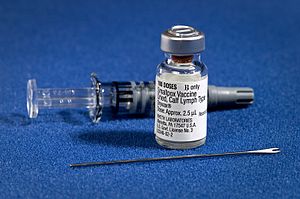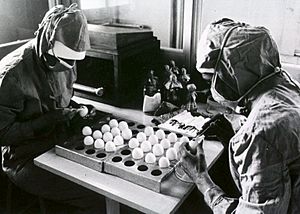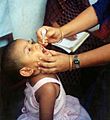Vaccine facts for kids
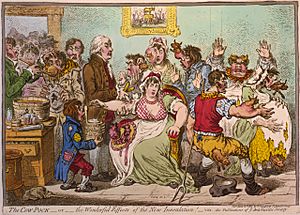
A vaccine helps your body get protection from a sickness that can spread. This sickness is usually caused by tiny germs called bacteria or viruses. When you get a vaccine, it makes you less likely to catch that disease. For example, the flu vaccine helps protect you from getting the flu.
Vaccines are often made from something that is alive, or was once alive.
The word "vaccine" comes from Latin words. Vaccīn-us comes from vacca, which means "cow". In 1796, Edward Jenner used cows that had cowpox. He used this to protect people from smallpox. Using vaccines is called vaccination.
Contents
How Vaccines Started
Edward Jenner made the first vaccine in the 1770s. At that time, smallpox was a very dangerous disease. Jenner noticed that people who had already caught cowpox usually did not get smallpox. Cowpox is a disease similar to smallpox. He thought that having cowpox protected people from smallpox.
To test his idea, Jenner gave a boy cowpox. After the boy recovered, Jenner then gave him smallpox. The boy did not get sick. Jenner was right: having cowpox protected people from smallpox.
Getting cowpox was safer than getting smallpox on purpose. So, England made smallpox inoculation illegal in 1840. In 1853, they made a new law. This law said every child had to get Jenner's vaccine against smallpox.
In the 1800s, Louis Pasteur created a vaccine for rabies.
In the 1900s, scientists made vaccines for diphtheria, measles, mumps, and rubella. In the 1950s, Jonas Salk created the polio vaccine.
However, there are still no vaccines for many important diseases. These include malaria and HIV.
Many countries have laws that require certain people to get vaccinated. For example, in many places, children must get certain vaccines to attend public school.
Kinds of Vaccines
There are different kinds of vaccines.
One common type is a "live vaccine." This vaccine has a tiny amount of a live virus or bacteria. Scientists make the virus or bacteria very weak. This way, it cannot make a person sick. When someone gets a live vaccine, their body's defense system learns to fight that germ. Then, if they meet the germ later, their body already "knows" how to fight it. Examples include vaccines for measles, mumps, and chickenpox.
Another common type is an "inactivated vaccine." These vaccines contain dead viruses or bacteria. They do not make the body's defense system react as strongly. Because of this, people might need "booster shots." These are extra doses of the vaccine given later. They help the body's defense system "learn" better. Examples include vaccines for pertussis (whooping cough), rabies, and hepatitis B.
Scientists can make some vaccines in a laboratory.
How Well Vaccines Work
Vaccines do not always give full protection from a disease. Sometimes, a person can still get a sickness they were vaccinated against.
This can happen if the person's body did not respond well to the vaccine. Their body did not "learn" how to fight the disease. This might happen if their body's defense system is already weak. This can be due to diabetes, HIV infection, old age, or certain medicines. It can also happen if their body cannot make the right cells to fight the germ.
Some vaccines protect people better than others. Here are some reasons why:
- Vaccination works better for some diseases.
- A vaccine might be for only one type of a disease. If a person gets a different type, they can still get sick.
- Vaccines usually do not last forever. So, a person might need many vaccines on a schedule. If a vaccine is missed, protection might be lost.
- Some people's bodies just do not create the right defenses. This happens even if they get the vaccine correctly.
- Things like family background, age, and genes can affect how a person reacts. Older people sometimes need bigger doses. Their body's defense system might not be as strong.
Making New Vaccines
Making new vaccines has some challenges. The diseases that need vaccines most today are HIV, malaria, and tuberculosis. These diseases are mostly found in poor countries. Companies that make vaccines might not earn much money from making vaccines for these diseases. This is because many people who need them are too poor to pay.
Throughout history, most vaccines have been made by governments, universities, and non-profit groups. Many vaccines have been very helpful for public health. In recent years, more vaccines are given around the world. This is especially true for children before they start school. This increase is often due to laws and government support.
Another challenge is that when a new vaccine is made, the maker often gets a patent. A patent keeps the way the vaccine is made a secret. This can make it harder for others to make similar vaccines.
What Else is in Vaccines?
Vaccines often contain other things besides the active part (the weakened or dead germ). For example, vaccines may contain:
- Aluminum salts or gels. These help the body's defense system react faster and stronger. They also allow a smaller dose of the vaccine to be used.
- Antibiotics. These are added to some vaccines to stop bacteria from growing while the vaccine is made or stored.
- Egg protein. This is in influenza and yellow fever vaccines. This is because they are made using chicken eggs. Vaccines can also have other proteins.
- Formaldehyde. This is used to kill bacteria for some vaccines. It also kills unwanted viruses and bacteria that might get into the vaccine.
- Monosodium glutamate (MSG) and 2-phenoxyethanol. These are used in a few vaccines to keep them stable. They stop the vaccine from changing if it gets too hot, too bright, too acidic, or too humid.
- Thimerosal. This is a preservative that has mercury. It is added to vaccine bottles that have more than one dose. It stops harmful bacteria from growing in the vaccine.
Preservatives in vaccines, like thiomersal, phenoxyethanol, and formaldehyde, help prevent problems. Thiomersal works well against bacteria. It lasts longer and makes the vaccine stronger and safer. However, in the United States, Europe, and some other developed countries, it is no longer used in childhood vaccines. This is because it contains mercury. Some people have said that thimerosal causes autism. But, there is no strong scientific evidence that this is true.
If no preservative is added, harmful bacteria can grow in the vaccine. For example, in 1928, Staphylococcus bacteria grew in a diphtheria vaccine. It had no preservative. Out of 21 children who got that vaccine, 12 died.
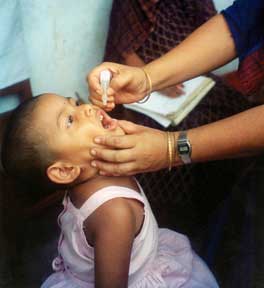
Vaccines for Animals
Animals also get vaccinated. This helps keep them from getting sick. It also stops them from passing diseases to humans. Pets and livestock (farm animals) are regularly vaccinated.
Sometimes, wild animals are vaccinated. This can be done by spreading food with vaccine in areas where diseases are common. This method has been used to control rabies in raccoons. Where rabies is found, laws may require dogs to get rabies vaccinations.
Dogs can also get vaccines for many other diseases. These include canine distemper, canine parvovirus, infectious canine hepatitis, adenovirus-2, leptospirosis, bordatella, canine parainfluenza virus, and Lyme disease.
New Ideas for Vaccines
- Today, people of all ages get vaccines.
- Vaccines that combine five or more parts are becoming more common.
- New ways to give vaccines are being made. These include skin patches, sprays breathed in, and eating genetically engineered plants.
- Scientists are making vaccines to make people's natural body defenses stronger.
- Scientists are trying to make vaccines to help cure long-lasting infections, not just prevent them.
- Public health experts might change how they give vaccines. This depends on how men, women, and pregnant women react to them.
Scientists are also working on vaccines for human diseases that are not infections. These include some cancers and autoimmune disorders. For example, a vaccine called CYT006-AngQb has been studied as a possible treatment for high blood pressure.
Images for kids
-
James Gillray, The Cow-Pock—or—the Wonderful Effects of the New Inoculation! (1802). Vaccinations eventually helped eliminate smallpox from the world.
-
This 1963 poster features the CDC's national mascot of public health, the "Wellbee", encouraging people to get an oral polio vaccine.
-
A child is vaccinated against poliomyelitis. This vaccine can be given orally, such as a few drops of liquid on a piece of sugar.
-
Maurice Hilleman's measles vaccine is estimated to prevent 1 million deaths every year.
See also
 In Spanish: Vacuna para niños
In Spanish: Vacuna para niños


